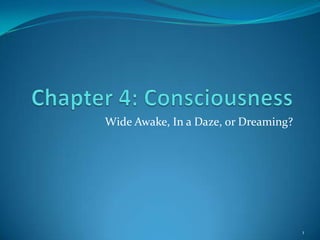
Chapter 4 Sleep P Pt2
- 1. Wide Awake, In a Daze, or Dreaming? 1
- 2. Sleep, Dreaming, and Circadian Rhythm Functions of Sleep: Sleep restores your body tissues and facilitates body growth. Sleep increases your immunity to disease. Sleep keeps your mind alert. Sleep helps you process memories Sleep enhances your mood. 2
- 3. How much sleep do we need? People differ in the amount of sleep they need. 1. 2. The older we get the less sleep we need. Babies require between 16-18 hours of sleep a day Preschools require 10-12 hours Teens need 8-10 hours Adults usually require at least 8 hours 3
- 4. Circadian Rhythm and our Biological Clock: 1. If we had no cues to time, our body would exhibit a sleep-wake cycle that approximates a 25 hour period – this is our circadian rhythm. 2. The suprachiasmatic nucleus, a group of brain cells in the hypothalmus, programs our circadian rhythm. 3. Our body automatically resets our biological clock back 1 hour- from a 25 hour cycle to 24 hours every day. 4
- 5. Sleep Stages Researchers, using electro-encephalogram 1. technology, have identified 5 stages of sleep. 2. They have identified two distinct sleep patterns: non-REM sleep and REM sleep. 3. When we are awake and alert, our brain emits beta waves, which are rapid, high frequency waves of electrical activity in the brain. 4. When we are awake and relaxed, the brain emits alpha waves. 5
- 6. There are 4 stages of non-REM sleep: 1. Stage I sleep: a light sleep characterized by theta waves, which are slower and less frequent than beta or alpha waves. Breathing slows Heart rate slows Sensations often of falling or floating Lasts from 1 to 7 minutes 6
- 7. 7
- 8. 2. Stage II Sleep: Is characterized by sleep spindles, which are a pattern of slow theta waves sporadically interrupted by burst of electrical activity. Lasts approximately 20 minutes Breathing, muscle tension, heart rate, and respiration continue to decrease. You are clearly asleep. Research shows that the sleep spindles play a role in memory processing of motor skills. 8
- 9. Stage III Sleep: It is a transitional stage. Delta waves begin. They are large, slow brain waves. When there is a consistent pattern of delta waves, you have entered stage IV sleep. 9
- 10. Stage IV Sleep: A deep sleep The body is extremely relaxed Growth hormone is secreted Body maintenance and restoration occur It is difficult to awaken people from this stage of sleep. If awakened, they are disoriented. Blood flow to the brain is reduced, and respiration, body temperature, and heart rate are slow. 10
- 11. REM SLEEP: After about 30 minutes of deep stage IV sleep, your brain and body starts to speed up again, and you cycle back through stages III and II of non-REM sleep, then enter REM Sleep. REM stands for “rapid eye movement” sleep. It is a very active stage. breathing increases The heart beats irregularly Muscle tone significantly decreases, leaving muscles extremely relaxed and essentially paralyzed The activity in the brain looks like you are awake! Although we can dream throughout all stages, dreams in REM sleep are most easily recalled. 11
- 12. A Typical Night’s Sleep: Initially, we progress through stages I, II, III, and IV 1. of non-REM sleep, then reverse back through III and II. Then we enter REM sleep. After a brief period in REM sleep, we begin the cycle 2. again, starting with the non-REM stages. One complete cycle takes about 90 minutes. 3. As the night progresses, we spend less time in deep 4. sleep and more time in REM sleep. On average, we spend 20% of our sleep time in REM. 5. If you are not getting enough sleep, you will miss out 6. on the longest period of REM sleep at the end of the night. 12
- 13. Why Do We Dream? 1.Freud called dreams “the royal road to the unconscious” in his book, The Interpretation of Dreams”. According to Freud, dreams allow us to express repressed fears, sexual desires, and aggressive feelings without the censorship of our conscious thought processes. He suggested that dreams contain both manifest content and latent content. 13
- 14. Another theory about dreaming is the Threat Simulation Theory: It posits an evolutionary function of dreams. Suggests that dreams are an ancient biological defense mechanism, that allows us to repeatedly stimulate potentially threatening situations, so we can rehearse our responses to the events. This theory explains the nightmares experienced by persons who have experienced childhood trauma. 14
- 15. The Activation Synthesis Theory: The theory suggests that dreaming is just the result of an aroused brain during REM sleep, when the brain shows activation of millions of random neural impulses. The cortex tries to create meaning out of the random firings by synthesizing them into familiar images or stories based on our stored memories. These stories may reflect: Our feelings Our past Information accessed during waking 15
- 16. Memory Theory This theory about dreaming suggests that dreams are a form of mental house-keeping. The dreams are a way of consolidating information and paring off trivial details– in this way they are a function of memory. 16
- 17. The Continuity Hypothesis: This theory says that dreams are a way of coping with daily problems and events. It suggests that we dream about everyday experiences and concerns in an effort to resolve difficulties and solve problems. 17
